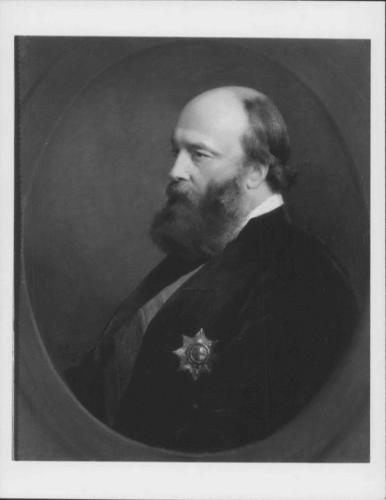Robert Gascoyne-Cecil, 3rd Marquess of Salisbury (1830-1903) Signed and dated 1887
Oil on canvas | 76.6 x 63.8 cm (support, canvas/panel/stretcher external) | RCIN 404831
-
George Richmond was a painter, draughtsman and engraver. He entered the Royal Academy Schools in 1824 and exhibited there for the first time a year later. In the same year he met William Blake at the Highgate house of John Linnell (ii). Like many other young artists of the period, including his lifelong friend Samuel Palmer, Richmond was much influenced by Blake. In 1827 he visited Samuel Palmer at Shoreham, during which time he became a prominent members of Palmer's 'Ancients', who were active in the Kent village in the late 1820s and early 1830s. Richmond's early works, such as Abel the Shepherd (1826; London, Tate) reflect the pronounced influence of both Blake and Palmer. They are painted in an archaic style and include Christian and literary themes and often obscure genre subjects. Richmond was also active as a draughtsman and miniaturist during this period, as well as practicing as a printmaker. This visionary phase in Richnond's career was relatively short-lived; always tempered by the more established ideas of his Academy training; he was further swayed by a trip to Paris in 1828 when he visited the Musée du Louvre to draw. Financial pressures also impacted Richmond's art. In 1831 he eloped with the daughter of architect and designer Charles Heathcote Tatham and the couple had ten surviving children, including William Blake Richmond. In the year of his marriage he began to actively produce portraits, which were to become his staple output for the rest of his life. Study of the Old Masters during several visits to Italy between 1837 and 1841 enhanced Richmond's portraiture and a Venetian richness of colour and monumentality of composition kept him in demand not only for society portraits but also for academic and clerical subjects.
Robert Gascoyne-Cecil was MP for Stamford, Secretary for India, Secretary for Foreign Affairs and Prime Minister. Disraeli described him as 'the only man of real courage that it has ever been my lot to work with'.
Queen Victoria thanked Lord Salisbury for the portrait and commented 'it is admirable & gives her the greatest pleasure'. The portrait is said to have been painted from memory, and the artist noted in a letter how unusual it was to have given pleasure with 'a portrait for which the Sitter never sat!'.
Signed and dated: GR /1887.Provenance
Presented to Queen Victoria by the Marquess and Marchioness of Salisbury, Golden Jubilee 1887
-
Creator(s)
(nationality)Acquirer(s)
-
Medium and techniques
Oil on canvas
Measurements
76.6 x 63.8 cm (support, canvas/panel/stretcher external)
96.9 x 84.1 x 8.9 cm (frame, external)
Category
Object type(s)








